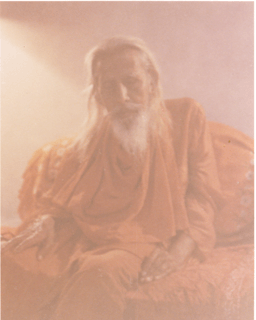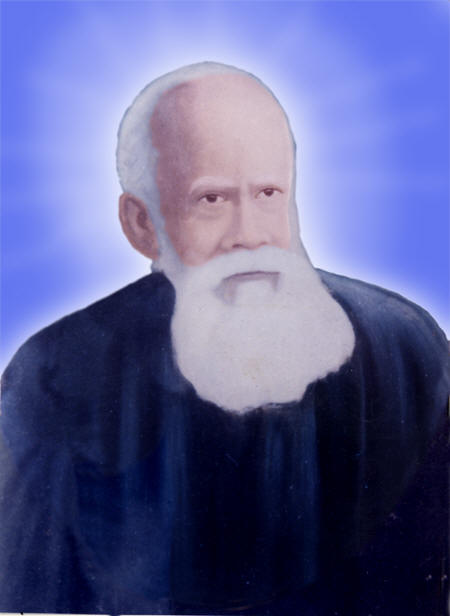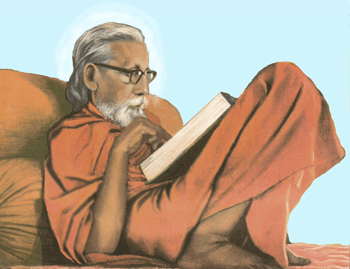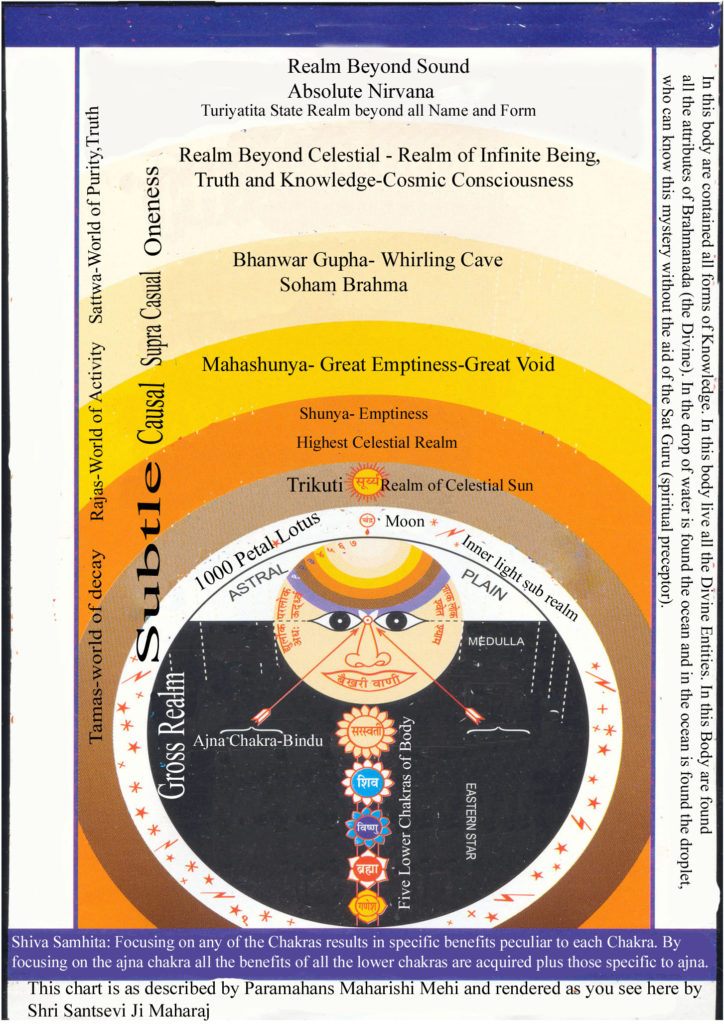
Articles and Links

The Art of Seeing
By Shri Santseviji Maharaj
Shortly before Shri Santseviji Passed from this world he collected many of his essays and poems which he had composed over the years into a book that has been named The Holy River (Ganges)Knowledge. There are 121 essays and poems below is a translation by Veena Howard of essay number 112.
What is the use of beautiful eyes when you do not understand the art of seeing. Just as a flower is beautiful, without a fragrant scent it is not so appealing. Sant Paltu Sahab says:
“What is the use of decorating your eyes if you do not know the art of seeing”.
By ‘art of seeing’ he is not talking about how to see beautiful scenery or magnificent sights. But rather he is referring to the practitioner (sadhak) on the spiritual journey. He is referring to the sadhana (spiritual practices) which allows one to develop the art of seeing. One may ask whether it is a practitioner of what—and what kind of art is Paltu Sahab speaking about?
There was a Fakir who lived in Allahabad in the 1600’s by the name of Malukadas Ji. He says: If we do not see the Divine Beings then these eyes are worth nothing. Without that ability to see the celestial he considers the eyes as of little value. Also he says: Who has not conquered desires how is that person able to love the Divine. If we can not see the unseeable then we are not using our eyes to the fullest extent possible. What kind of eyes are we speaking about here. Are we talking about the physical eyes composed of flesh— no. Sant Kabir says you can not see the celestial subtle with these physical eyes of the flesh. Rather, we must acquire the inner eyes-the eyes of the soul. The saints say if God could be realized in the physical world then the physical eyes would be sufficient to see these celestial sights. However, this is not the case. Even though, God is all pervasive he can only be seen within. Once we can see Him within then and only then can we see him outside. Therefore, it is important to turn the attention from outside to the inward. Swami Vivakanda explains: What is the meaning of seeing the divine inside. He says all the worldly things are beautiful but looking at them is not the way to see the divine. We should turn our Dristi (power of seeing) inward. First one has to curb the eyes desire to look outward and then one must have a desire to look inward. When the desire to look outward diminishes then one is able to see the grandeur of God within. In this regards Sant Charandas Ji says: Only a bird can understand the birds language, other animals are unable to understand the birds. A female saint named
Sahjo Bhai had a pure heart. In her happiness to understand she says that her Guru became happy with me a told me the secret of seeing the Divine. No one can see the
subtle celestial by looking into this physical world, only by looking within using the art of seeing can we understand the celestial. Therefore one must turn inward to understand this Formless Atman the inner self.
In the Katha Upanishad it is said that the Divine has created these senses to go outwardand away from our true identity. Some patient and persevering practitioner desires the nectar of the inner world and brings the outward senses to the inward journey. If after hearing about the possibilities of the inner journey how do we behold and experience this. Seeing in this way is called Dristi-that is the art of seeing.
There are five kinds of Dristi.
1. The sight of the waking state. That is seeing things in the everyday world.
2. The sight of dream state in which we see the dreams.
3. Manasi Dristi which is seeing with the minds eye. This is the realm of the
imagination and seeing while imagining.
4. Divya Dristi is divine sight. Through which the vision of the celestial worlds is
seen.
5. Atman Dristi is the state of seeing the Absolute Self.
In considering these five types of seeing everyone in this mundane world experiences the first three. The last two are only developed through meditation. In regard to Divya Dristi Sant Paltu Sahab says that without this one cannot see the Absolute Atman. Therefore, it is important to learn how to obtain these last two. There
are two methods for achieving this.
First, to begin the process of experiencing Divya Dristi and Atman Dristi the saints say that by controlling and stopping the first three types of seeing then the mind becomes under control and it will be possible to experience Divya Dristi. So when the first three types of seeing are halted and while in a conscious state we attain Divya Dristi. In the process of curbing these first we must curb sight in the waking state as the mind constantly is considering what it has seen. (The more enticing a scene is, the stronger will be our attachment to it and accordingly it will be more difficult to rid oneself of such (thoughts.) The dream state is also affected by the sights we see in the waking state. So by controlling sight in the waking state the dream state is also controlled. Therefore, we should see and experience those things which will help our spiritual journey. We should not witness those things which are counterproductive to the spiritual life and which increase our desire to experience more and to go outward. Sant Goraknath said: We should be careful in each action performed each day, careful of what we say and what we do. We should watch our path carefully. Mahatma Gandhi says: God has given us these eyes, we make them impure and we do not learn what is proper to see. There is a difference in seeing, between a disciplined yogi and a person seeking pleasure. The Yogi uses his eyes to see the Divine and goes inward. The pleasure seeker looks at those things which give enjoyment and pleasure and goes further outward. Gandhi says not to waste our time in seeking after these pleasures of the world, he does not recommend movies
even. Someone has said that in regards to the senses that we should enjoy things but do not be attached, talk but do not gossip, see the things of the world but do not be attached.
The second method for controlling the seeing is to sit in a clean place with the back and spine erect, the asana (seated position) firm with the eyes closed, however do not stress the eyes or pinch them or strain them in any way. Since we are always seeing things and events during the waking state they naturally these same events come to us during meditation. Therefore, through pratyahara 1 we constantly are bringing the mind back to the object of the meditation and focusing intently on that. Then we begin to abandon these scenes of the world. The object should be on the holiest object. A divine image or an image of the Sat Guru should be employed. We must stare at the form intently without flickering the eyes or moving the eyes, simply and firmly focused. We should focus without thoughts on this holy form without having any thoughts. In this practice the mind begins to be controlled and focused and we gain some power to enter the subtle celestial realms. We begin to know the thoughts of others etc. To make further progress we use the minute Bindu (infinitesimal point). The Tejabindu Upanishad says that the meditation on the light bindu requires perfect focus, it actually exists and is established within each of us. We have only to realize it. By meditating on this point (bindu) full concentration of the mind becomes possible. Once full concentration is accomplished the mind then goes upward and we pierce the realm above. When consciousness is directed
inward and we are in the dark realm of this gross world then we are brought to the realm of light through the focus on bindu.
Maharishi Mehi says: Dristi is the power of seeing by uniting beams of both eyes on the point. Only then the mind becomes focused. Now there is no difference between
opening up the Divya Dristi and the art of seeing they are the same. Sant Paltu Sahab speaks about Bhungi which is the method of mediation where one stares at one place without interruption as instructed by the Guru. This results in Divya Dristi. Once the Divine sight is attained then the practitioner automatically begins to experience the divine sound and the Divya -Divine seeing is less prominent and the sound becomes dominant. This is so because of the power of the sound to attract, and through the use of divine sounds one transcends and rises to higher and higher realms until one becomes established in the Divine and one then is seeing ones own inner essence from the level of Atman Dristi the fifth type of seeing.
1
Pratyahara is one of the eight limbs of Yoga according to Patanjali. It is in reference to meditation and
admonishes the practitioner to return constantly to the object (single thought) of the meditation. This
strengthens the mind and prepares it for Dhyan or continuous uninterrupted focus on a single thought.
Shri Santsevi Ji Maharaj ,Maharishi Mehi and other Santmat Saints public lectures translated by Pravesh K. Singh: in PDF format, double click link below to open in Adobe PDF format:
Posted 7/14/07 Behold the Moon as well as the Sun Within You1.pdf
Posted 7/17/07 Cleanse Your Mind – English Translation.pdf
Posted 7/20/07 Jnaan Yoga Bhakti.-
Posted 8/01/07 Perseverance Pays – Santseviji.pdf—This was the last and parting satsang by Shri Santsevij Maharaj given June 3rd, one day before his mahasamdhi
Posted 8/20/07 Know Thyself.pdf–This was a Satsang given in Rishikesh 1997
Posted 10/27/07 Maharishi Mehi Bridge of Knowledge–commentary by Pravesh Singh
Posted 10/27/07 Short Discourse of Shri Santseviji Maharaj– unknown date
Posted 11/25/07 Mystic Poems of Baba Devi Sahab -unknown date, translated by Pravesh Singh
Posted 11/25/07 Strike a Balance Between Spiritual and Worldly Life by Maharishi Mehi -unknown date, translated by Pravesh Singh
Posted 11/25/07 Live Righteously by Shri Sansevi Ji Maharaj-12/20/2002, translated by Pravesh Singh
Posted 02/10/08 Couplets of Swami SantSevi Ji.pdf
Posted 02/10/08 Radhaswami and Maharishi Mehi quotes.pdf
Posted 02/10/08 Talks with Maharshi Mehi Paramhans.pdf
Posted 02.10/08 The Vedas and Santmat Maharishi Mehi.pdf
Posted 02/10/08 To Know Your Self is to Know God.pdf
Below is a Chart of realms translated from Hindi by Veena Howard. These realm are referenced in The Philosophy of Liberation


Additional Links
The Below links are santmat related and some are quite good. Due to the few English translations from the path of The Way of Sages we recommend other sources for a broader knowledge of the Santmat path. Be aware that other branches do differ from our specific path. Particularly, in our mediation techniques we differ considerably. For those who practice our meditation we caution that other paths of Santmat have these differences. It is our belief and that of Shri SantseviJi Maharaj that these other paths offer a valid approach which leads to the light and sound experiences and eventually lead to the state of Oneness. Special Thanks to James Bean who provided the below links. You might also like to visit James Bean web site Spiritualawakening,com for an expanded view of Santmat.
An Introduction to Sant Mat
Surat Shabd Yoga, by Kirpal Singh, a free online book — as a PDF file http://www.ruhanisatsangusa.org/pdf/SuratShabdYoga.pdf
Free book online, Songs of Kabir,
Translated by Rabindranath Tagore
100 Mystic-Poems of Guru Kabir:
http://www.sacred-texts.com/hin/sok/index.htm
Jap Ji — the Morning Prayer of Guru Nanak — online:
http://www.ruhanisatsangusa.org/jj/title.htm
in book form via MediaSeva.com: http://www.mediaseva.com
A Sant Mat Dictionary of Mystic Terms
“Glossary of the Radhasoami Faith”
by S. D. Maheshwari of Soami Bagh, Agra
India Website:
http://www.radhasoami-faith.info/Books_Frame.shtml
Param Sant Tulsi Sahib, the Saint of Hathras
English anthology of his writings, by S. D. Maheshwari:
http://www.radhasoami-faith.info/Books_Frame.shtml
(Also see contact info above for Banyen Books of Vancouver.)
